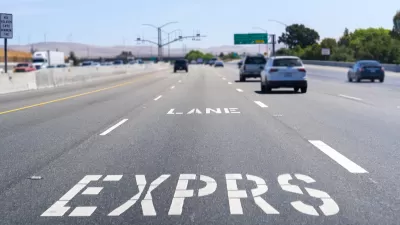Since the Federal Highway Administration relaxed a rule against digital billboards in 2007, communities across the country have struggled with how to balance concerns about distracted drivers and disfigured landscapes with the desires of advertisers.
"Communities around the country increasingly are in fights over digital billboards: glaring, changeable roadside signs that visually scream for attention," reports Larry Copeland. Los Angeles, for instance, has been debating their presence since before the Federal Highway Administration "relaxed a rule against digital billboards on federal highways in 2007." Since that ruling, says Copeland, the number of digital billboards on local streets and freeways "has exploded" - "from 1,800 to 4,000 since 2010, according to industry group Outdoor Advertising Association of America."
"Critics, such as the conservation group Scenic America, call them 'TV on a stick' that distract drivers, disfigure the landscape and disturb the sleep of nearby residents."
"They create 'a Las Vegas effect,' says county Commissioner Richard Briggs of Knox County, Tenn., who's trying to stop companies from converting existing billboards into digital signs."
"I'm very pro-business, but I believe in protecting the aesthetic of our community," Briggs says. "I like Las Vegas, but that's not what we want here in the cradle of Southern Appalachia."
FULL STORY: Cities snipe over super-bright digital billboards

Maui's Vacation Rental Debate Turns Ugly
Verbal attacks, misinformation campaigns and fistfights plague a high-stakes debate to convert thousands of vacation rentals into long-term housing.

Planetizen Federal Action Tracker
A weekly monitor of how Trump’s orders and actions are impacting planners and planning in America.

In Urban Planning, AI Prompting Could be the New Design Thinking
Creativity has long been key to great urban design. What if we see AI as our new creative partner?

King County Supportive Housing Program Offers Hope for Unhoused Residents
The county is taking a ‘Housing First’ approach that prioritizes getting people into housing, then offering wraparound supportive services.

Researchers Use AI to Get Clearer Picture of US Housing
Analysts are using artificial intelligence to supercharge their research by allowing them to comb through data faster. Though these AI tools can be error prone, they save time and housing researchers are optimistic about the future.

Making Shared Micromobility More Inclusive
Cities and shared mobility system operators can do more to include people with disabilities in planning and operations, per a new report.
Urban Design for Planners 1: Software Tools
This six-course series explores essential urban design concepts using open source software and equips planners with the tools they need to participate fully in the urban design process.
Planning for Universal Design
Learn the tools for implementing Universal Design in planning regulations.
planning NEXT
Appalachian Highlands Housing Partners
Mpact (founded as Rail~Volution)
City of Camden Redevelopment Agency
City of Astoria
City of Portland
City of Laramie





























